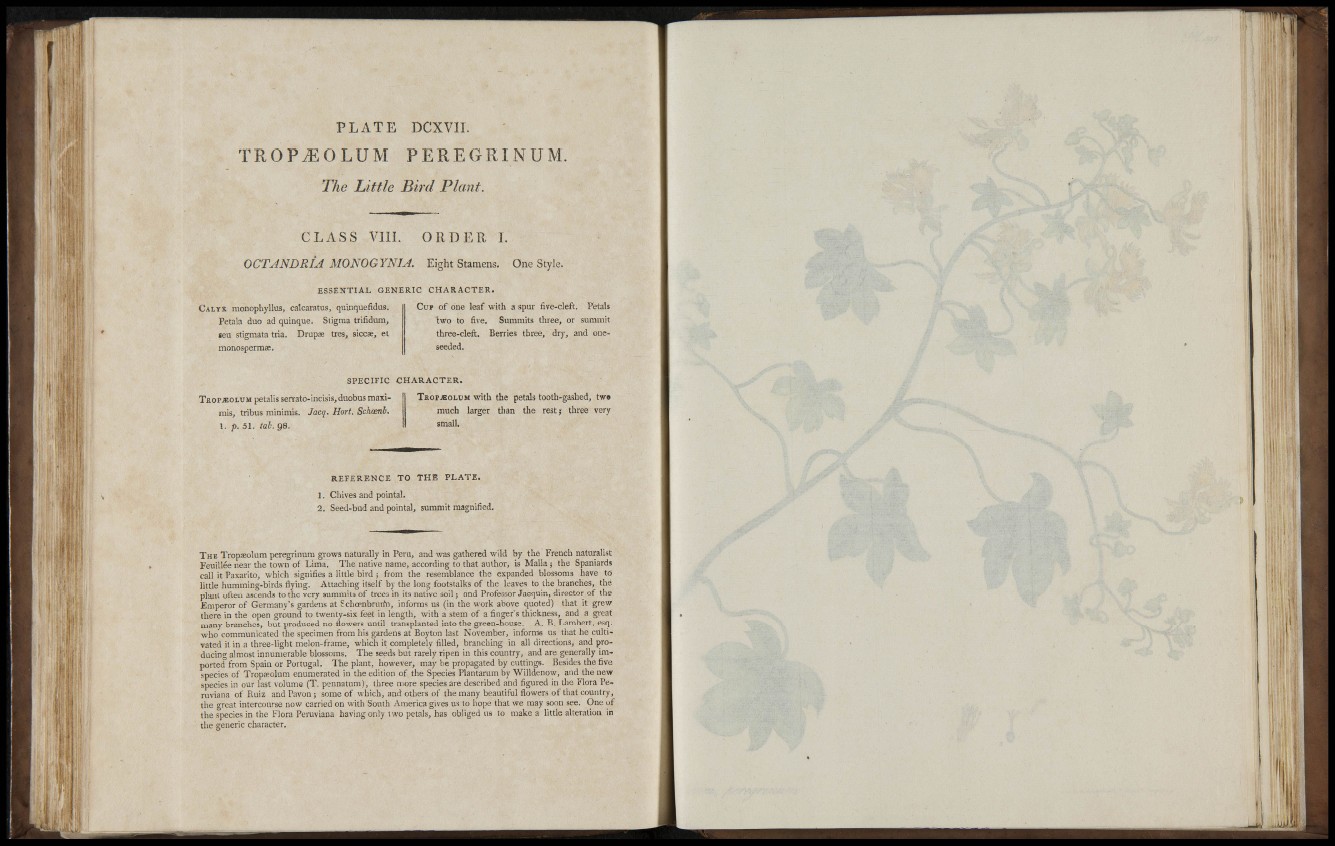
•r I
•1 \
P L A T E DCXVII.
T R O P t E O L U M PEREGRINUM.
The Little Bird Plant.
C L A S S VIIL ORDER I.
OCTJNDRI'A MONOGYNIA. Eight Stamens. One Style.
ESSENTIAL GENERIC CHARACTER.
Ca l y x monophyllus, calcaratus, quLnquefidus.
Petals duo ad quinqué. Stigraa trifidum,
teu stigmata tria. Drupae tres, siccse, el
monospermae.
CUP of one leaf with a spur five-cleft. Petals
Iwo to five. Summits three, or summit
three-cleft. Berries three, dry, and oneseeded.
SPECIFIC CHARACTER.
Tr o p j e o l um petalis serrato-incisis, duobus maximiSj
tribus minimis. Jacq. Hort. Schoenl.
1. p. 51. tal. 98.
Trop-Solum with the petals tooth-gashed, two
much larger tlian the rest} three very
small.
REFERENCE TO THE PLATE.
]. Chives and pointal.
2. Seed-bud and pointal, summit magnified.
THE Tropaeolum peregrinum grows naturally in Peru, and x^^as gathered wild by the French naturalist
Feuillée near the town of Lima. The native name, according to that author, is Malla ; the Spaniards
call it Paxarito, which signifies a little bird ; from the resemblance the expanded blossoms have to
little humming-birds flying. Attaching itself by the long footstalks of the leaves to the branches, thé
plant often ascends to the very summits of trees in its native soil ; and Professor Jacquin, director oí the
Emperor of Germany's gardens at Schoenbrun'n, intbrms us (in the work above quoted) that it grew
there in the open ground to twenty-six feet in length, with a stem of a finger's thickness, and a great
many branches, but produced no tlowers until transplanted into the green-house. A. B. Lambert, esq.
who communicated the specimen from his gardens at Boyton last November, informs us that he cultivated
it in a three-light melon-frame, which it completely filled, branching in all directions, and producing
almost innumerable blossoms. The seeds but rarely ripen in this country, and are generally imported
from Spain or Portugal. The plant, however, may be propagated by cuttings. Besides the five
species of Tropaeolum enumerated in the edition of the Species Plantarum by Willdenow, and^ the new
species in our last volume (T. pennatum), three more species are described and figured in tlie Plora Peruviana
of Ruiz andPavon; some of which, and others of the many beautiful flowers of that country,
the great intercourse now carried on with South America gives us to hope that we may soon see. One of
the species in the Flora Peruviana having only two petals, has obliged us to make a little alteration in
the generic character.
r 1
Kl
1 - 1 '
: I
Í ií¡5
!
slii ^
•f I
mm